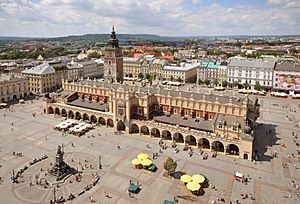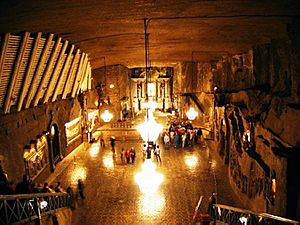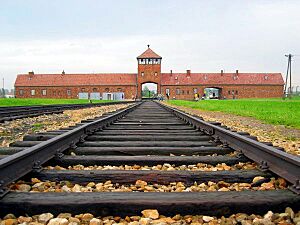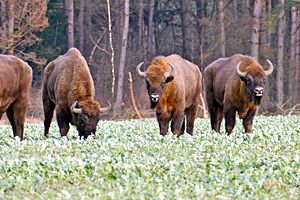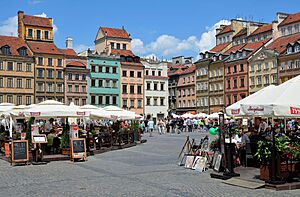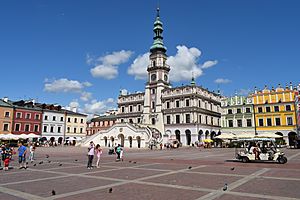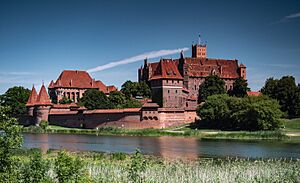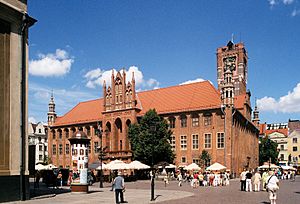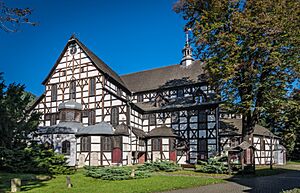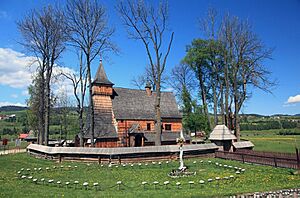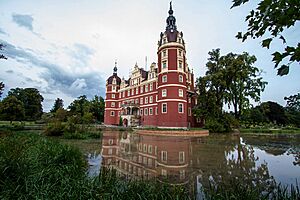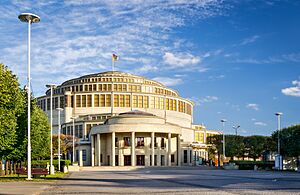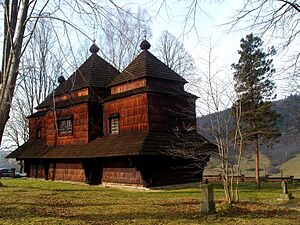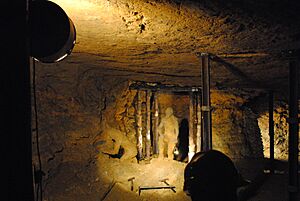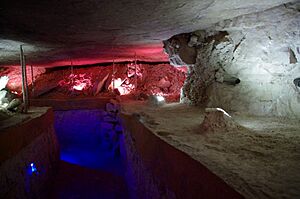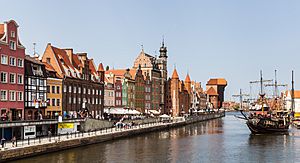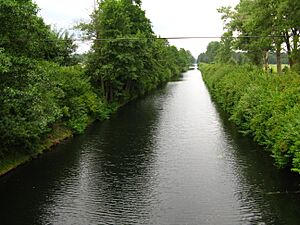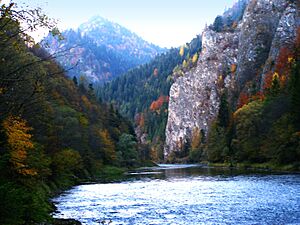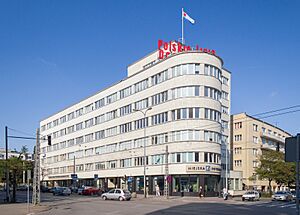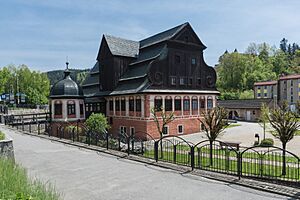List of World Heritage Sites in Poland facts for kids
Have you ever heard of places so special they are protected for everyone to enjoy? The United Nations Educational, Scientific and Cultural Organization (UNESCO) helps find and protect these amazing spots around the world. They are called World Heritage Sites. These sites can be important for their culture or their natural heritage.
Cultural sites include old buildings, sculptures, or even archaeological digs. Natural sites are things like unique landforms, special places for animals and plants, or beautiful natural areas. Poland joined this effort in 1976, which meant its own special places could be added to the list.
As of 2021[update], Poland has 17 World Heritage Sites. Most of them (15) are cultural, showing off Poland's rich history. Two are natural, celebrating its beautiful landscapes. The very first sites added in 1978 were the Wieliczka Salt Mine and the Historic Centre of Kraków. The newest addition, in July 2021, is the Bieszczady National Park.
Some of these sites are so important that they are shared with other countries! For example, the Białowieża Forest is also in Belarus. The Wooden Tserkvas are shared with Ukraine. The Muskauer Park / Park Mużakowski is partly in Germany. And the Primeval Beech Forests are shared with 18 other European countries! Poland also has five more sites that might become World Heritage Sites in the future.
Poland's Amazing World Heritage Sites
UNESCO chooses sites based on ten special rules, called criteria. Each site must meet at least one of these rules. Criteria i to vi are for cultural sites, and vii to x are for natural sites.
* Transnational site
| Site | Image | Location | Year listed | UNESCO data | What Makes It Special |
|---|---|---|---|---|---|
| Historic Centre of Kraków | Lesser Poland | 1978 | 29bis; iv (cultural) | Kraków was once the capital of Poland. Its old center has three main parts: the medieval city, Wawel Hill (a royal home and burial place for kings), and the old Jewish town of Kazimierz. Kraków was a hub for art and trade, mixing ideas from East and West. You can see buildings from very old styles like Romanesque to more modern ones. | |
| Wieliczka and Bochnia Royal Salt Mines | Lesser Poland | 1978 | 32ter; iv (cultural) | These salt mines have been dug since the 1200s! Inside, there are hundreds of kilometers of tunnels. You'll even find amazing art, like sculptures carved from salt, and underground chapels. They show how mining technology grew in Europe. Wieliczka was first listed alone. Bochnia Mine was added in 2013. | |
| Auschwitz Birkenau, German Nazi Concentration and Extermination Camp (1940–1945) | Lesser Poland | 1979 | 31; vi (cultural) | Auschwitz was a large group of camps built and run by the Nazis during World War II. It was the biggest of the German concentration camps. The site includes Auschwitz I (the main camp), Auschwitz II–Birkenau (where many people were killed), and mass graves. It is a powerful reminder of a very sad time in history. | |
| Białowieza Forest* | Podlaskie | 1979 | 33; vii (natural) | This huge forest sits on the border between Poland and Belarus. It's one of the last and largest parts of the ancient forests that once covered Europe. It's home to the biggest group of wild European bison, as well as wolves, lynxes, and otters. The Polish part was listed in 1979, and the Belarusian part was added later. | |
| Historic Centre of Warsaw | Masovia | 1980 | 30; ii, vi (cultural) | Warsaw, Poland's capital, was almost completely destroyed by Nazi troops in 1944. Over 85% of its historic center was ruined. After the war, people worked for five years to carefully rebuild the Old Town, making it look just like it did before. The Royal Castle was reopened in 1984. | |
| Old City of Zamość | Lublin | 1992 | 564; iv (cultural) | Zamość was built in the 1500s by Jan Zamoyski and designed by an Italian architect. It's a perfect example of a late-Renaissance town. The original layout, strong walls, and many buildings are still there. They mix Italian design with Central European styles. | |
| Castle of the Teutonic Order in Malbork | Pomerania | 1997 | 847; ii, iii, iv (cultural) | This huge castle was built by the Teutonic Knights, a German religious order, in the 1300s. It's a great example of a medieval castle made of brick, in a style called Brick Gothic. The castle was damaged during World War II but has been carefully rebuilt. | |
| Medieval Town of Toruń | Kuyavia-Pomerania | 1997 | 835; ii, iv (cultural) | Toruń was founded by the Teutonic Knights in the mid-1200s. It became an important trading city in the Hanseatic League. The medieval town is very well preserved, including old houses in the Brick Gothic style. This is also the hometown of the famous astronomer Nicolaus Copernicus. | |
| Kalwaria Zebrzydowska: the Mannerist Architectural and Park Landscape Complex and Pilgrimage Park | Lesser Poland | 1999 | 905; ii, iv (cultural) | This religious site was started in the early 1600s. It has a monastery, churches, chapels, and shrines built in the Mannerist style. It's a great example of a Calvary shrine from that time. It looks almost exactly as it did when it was built and is still a popular place for pilgrimages today. | |
| Churches of Peace in Jawor and Swidnica | Lower Silesia | 2001 | 1054; ii, iv, vi (cultural) | These churches in Jawor and Świdnica were built after a peace treaty in 1648. This treaty allowed Lutherans to build three churches from wood and clay outside city walls. They couldn't have towers and had to be finished in one year. The third church burned down later. These two are amazing examples of unique wooden architecture. | |
| Wooden Churches of Southern Lesser Poland | Lesser Poland | 2003 | 1053; iii, iv (cultural) | These six churches are the oldest and best-preserved wooden churches in the region. They were built in the Gothic style, but they are very different from the stone or brick churches in cities. Rich families paid for these churches, and they are beautifully decorated inside. | |
| Muskauer Park / Park Mużakowski* | Lubusz | 2004 | 1127; i, iv (cultural) | This park is located along the Neisse River and is shared by Poland and Germany. It was designed between 1815 and 1844, using local plants and natural features. The park's design was so good that it influenced how landscape architecture developed. It was badly damaged in World War II but has been restored in both countries. | |
| Centennial Hall | Lower Silesia | 2006 | 1165; i, ii, iv (cultural) | The Centennial Hall is an early Modernist building made of reinforced concrete. It was designed to be a place for exhibitions, meetings, sports, concerts, and plays. Built in 1911–1913, it had the largest reinforced concrete dome in the world at that time. It became an important example for future buildings made with this material. | |
| Wooden Tserkvas of the Carpathian Region in Poland and Ukraine* | Lesser Poland, Subcarpathia | 2013 | 1424; iii, iv (cultural) | This site includes 16 wooden churches, called tserkvas, in the Carpathians mountains. Half are in Poland and half in Ukraine. These churches were built between the 1500s and 1800s by Eastern Orthodox and Greek Catholic communities. They have unique wooden bell towers, beautiful screens inside, and colorful decorations. The St. Michael Archangel's Church in Smolnik is one example. | |
| Tarnowskie Góry Lead-Silver-Zinc Mine and its Underground Water Management System | Silesia | 2017 | 1539; i, ii, iv (cultural) | This old mine dug for lead, silver, and zinc in Tarnowskie Góry. Because it was on flat land, it was hard to get water out of the tunnels. For over 300 years, miners used different ways to remove water, including steam-powered pumps in the 1800s. It shows amazing engineering for its time. | |
| Krzemionki Prehistoric Striped Flint Mining Region | Świętokrzyskie | 2019 | 1599; iii, iv (cultural) | Krzemionki is a group of four striped flint mines from the Stone Age and early Bronze Age (around 3900 to 1600 BCE). Flint was mainly used to make axes. Over 4,000 shafts and pits, plus workshops, have been found here. It's one of the most complete ancient underground mining systems ever discovered. | |
| Ancient and Primeval Beech Forests of the Carpathians and Other Regions of Europe* | Subcarpathia | 2021 | 1133quater; ix (natural) | This site includes forests in 18 European countries. These forests show how European beech trees spread across Europe after the last Ice Age. They are great examples of how pure and mixed beech forests grow in different environments. The Bieszczady National Park in Poland was added to this list in 2021. |
Future World Heritage Sites: Poland's Tentative List
Besides the sites already on the World Heritage List, countries can suggest new places they think are special enough to be added. This is called a "tentative list." A site must be on this list first before it can be officially nominated. As of 2022, Poland has five places on its tentative list.
| Site | Image | Location | Year listed | UNESCO criteria | What Makes It Special |
|---|---|---|---|---|---|
| Gdansk—Town of Memory and Freedom | Pomerania | 2005 | ii, iv, vi (cultural) | The city of Gdańsk has seen some very important moments in European history. This includes the start of World War II at Westerplatte and the beginning of the Solidarity movement at the Gdańsk Shipyard. The historic Main Town also has many beautiful Gothic and Renaissance buildings. | |
| Augustów Canal* | Podlaskie | 2006 | (cultural) | The Augustów Canal was built between 1823 and 1839. It created a direct water link between major rivers, helping trade routes avoid high taxes in other areas. This amazing engineering project includes locks, weirs, and bridges. The canal is now in both Belarus and Poland. | |
| The Dunajec River Gorge in the Pieniny Mountains | Lesser Poland | 2006 | (natural) | The Dunajec River Gorge, located in the Pieniny National Park, is rich in different plants and animals. Because the Pieniny Mountains were not covered by glaciers, this area is a great place to study how plants have grown and changed since the last Ice Age. | |
| Modernist Centre of Gdynia — the example of building an integrated community | Pomerania | 2019 | ii, iv, v (cultural) | After World War I, Poland needed a new main port. So, the small village of Gdynia was chosen. In the 1920s and 1930s, a new, modern city center was built. The population grew from 1,200 to 120,000 people! Gdynia became a symbol of Poland's modernization and its goals for sea trade. | |
| Paper Mill in Duszniki-Zdrój | Lower Silesia | 2019 | iii, iv (cultural) | The Paper Mill in Duszniki-Zdrój is one of the oldest paper mills still standing in Europe. It was built in the 1500s and brought a lot of wealth to its owners. In 1968, it became a museum. When it was nominated, the mill was still making traditional handmade paper! |
See also
 In Spanish: Anexo:Patrimonio de la Humanidad en Polonia para niños
In Spanish: Anexo:Patrimonio de la Humanidad en Polonia para niños
- List of Historic Monuments in Poland
- Seven Wonders of Poland
- Tourism in Poland
- UNESCO Memory of the World Register


